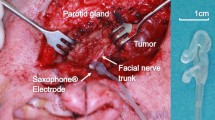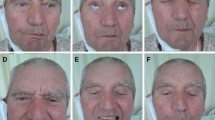Abstract
Objectives
To investigate a method for predicting postoperative facial nerve paralysis (POFNP) during parotid surgery using intraoperative nerve monitoring (IONM).
Methods
We assessed prediction for POFNP by using IONM, comparing between stimulation in the facial nerve trunk and each branch by using facial nerve monitoring. The amplitude response ratio (ARR) was calculated for the trunk/periphery. In addition, we then examined the correlation between ARR and time to recovery of paralyzed branches.
Results
372 branches of 93 patients did not develop POFNP and were classified as group A. Among 20 patients who developed POFNP, 51 branches without POFNP were classified as group B, and 29 branches with POFNP were classified as group C. The ARR was approximately 1 in group A and B. but less than 0.5 in all branches in Group C. When the cut off value of ARR was set at 0.55, the sensitivity, specificity, and accuracy of POFNP diagnosis by ARR were 96.5%, 93.1%, and 96.8%, respectively.
Conclusion
Using IONM during parotid surgery enables easy prediction of POFNP.




Similar content being viewed by others
Data Availability
Raw data were generated at Osaka Medical and Pharmaceutical University. Derived data supporting the findings of this study are available from the corresponding author, Masaaki Higashino, on request.
References
Eisele DW, Wang SJ, Orloff LA (2010) Electrophysiologic facial nerve monitoring during parotidectomy. Head Neck 32:399–405
Sood AJ, Houlton JJ, Nguyen SA, Gillespie MB (2015) Facial nerve monitoring during parotidectomy: a systematic review and meta-analysis. Otolaryngol Head Neck Surg 152:631–637
Kinoshita I, Kawata R, Higashino M, Nishikawa S, Terada T, Haginomori SI (2021) Effectiveness of intraoperative facial nerve monitoring and risk factor s related to postoperative facial nerve paralysis in patients with benign parotid tumors: a 20-year study with 902 patients. Auris Nasus Larynx 48(3):361–367
Savvas E, Hillmann S, Weiss D, Koopmann M, Rudack C, Alberty J (2016) Association between facial nerve monitoring with postoperative facial paralysis in parotidectomy. JAMA Otolaryngol Head Neck Surg 142:828–833
Graciano AJ, Fischer CA, Coelho GV, Steck JH, Paschoal JR, Chone CT (2018) Facial nerve dysfunction after superficial parotidectomy with or without continuous intraoperative electromyographic neuromonitoring: a prospective randomized pilot study. Eur Arch Otorhinolaryngol 275:2861–2868
Grosheva M, Klussmann JP, Grimminger C et al (2009) Electromyographic facial nerve monitoring during parotidectomy for benign lesions does not improve the outcome of postoperative facial nerve function: a prospective two-center trial. Laryngoscope 119:2299–2305
Meier JD, Weniq BL, Manders EC, Nenonene EK (2006) Continuous intraoperative facial nerve monitoring in predicting postoperative injury during parotidectomy. Laryngoscope 116:1569–1572
Mamelle E, Bernat I, Pichon S et al (2013) Supramaximal stimulation during intraoperative facial nerve monitoring as a simple parameter to predict early functional outcome after parotidectomy. Acta Otolaryngol 133:779–784
Kawata R, Lee R, Araki M, Takenaka H (2007) Safety and usefulness of an electric knife during surgery for parotid benign tumor: postoperative facial paresis and its risk factors. Acta Otolaryngol 127:966–969
Witt RL (2002) The significance of the margin in parotid surgery for pleomorphic adenoma. Laryngoscope 112:2141–2154
Author information
Authors and Affiliations
Contributions
MH designed the study. MH, IK, TJ, and TT acquired all data. M.H. wrote the manuscript. RK supervised the study. All authors performed data analysis and interpretation and approved the manuscript.
Corresponding author
Ethics declarations
Conflict of interest
The authors declare that they have no conflicts of interest.
Additional information
Publisher's Note
Springer Nature remains neutral with regard to jurisdictional claims in published maps and institutional affiliations.
Rights and permissions
Springer Nature or its licensor (e.g. a society or other partner) holds exclusive rights to this article under a publishing agreement with the author(s) or other rightsholder(s); author self-archiving of the accepted manuscript version of this article is solely governed by the terms of such publishing agreement and applicable law.
About this article
Cite this article
Higashino, M., Kinoshita, I., Jinnin, T. et al. Predicting postoperative facial nerve paralysis by using intraoperative nerve monitoring during parotid surgery. Eur Arch Otorhinolaryngol 280, 3855–3860 (2023). https://doi.org/10.1007/s00405-023-07973-3
Received:
Accepted:
Published:
Issue Date:
DOI: https://doi.org/10.1007/s00405-023-07973-3




